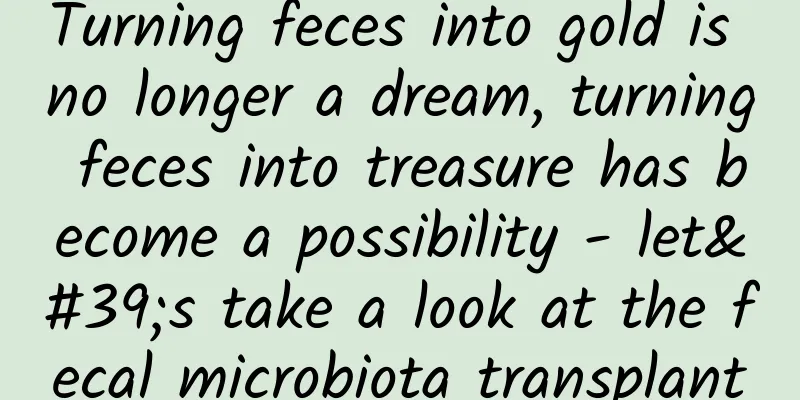Turning feces into gold is no longer a dream, turning feces into treasure has become a possibility - let's take a look at the fecal microbiota transplant

|
What is a fecal microbiota transplant? Fecal microbiota transplantation is to transplant the functional flora in the feces of healthy people into the gastrointestinal tract of patients with intestinal flora imbalance, rebuild the intestinal flora, and achieve the treatment of intestinal and extra-intestinal diseases. It is also called " fecal transplantation ", " fecal microbiota therapy ", " intestinal microbiota therapy " or " intestinal microecological transplantation ". Fecal microbiota transplantation in history The prototype of fecal microbiota transplantation appeared in my country 1,700 years ago. As early as the Eastern Jin Dynasty, Ge Hong[1] proposed taking "Huanglong Decoction" to improve intestinal diseases in his "Emergency Prescriptions for the Elbow" - using human feces to treat patients with food poisoning, diarrhea, fever and dying. " Drink one liter of feces juice and you will be alive ", which shows its miraculous effect. After years of practice, Li Shizhen of the Ming Dynasty recorded in detail in his Compendium of Materia Medica the use of fermented feces supernatant, fresh feces juice, dried feces and infant feces to treat gastrointestinal diseases such as diarrhea, constipation and abdominal pain. Today, we can still find evidence of " using feces as medicine " in traditional Chinese medicine. The earliest record of fecal microbiota transplantation in humans in modern Western medicine was in 1958[2]. At that time, a gastrointestinal disease called pseudomembranous colitis had a mortality rate of up to 75%, and conventional treatments were generally ineffective. Surgeon Ben Eisman and his colleagues injected feces from healthy people into the intestines of four patients with pseudomembranous colitis through the rectum. As a result, three of the seriously ill patients recovered, while the other patient died of a disease unrelated to intestinal infection. However, this method was not taken seriously. Twenty years later, scientists confirmed that pseudomembranous colitis was caused by excessive growth of a bacterium called Clostridium difficile . Since then, " fecal microbiota transplantation " has gradually been restarted in the medical community. It was not until 2013 that fecal microbiota transplantation was officially included in the US clinical medicine guidelines [3] for the treatment of Clostridium difficile infection. Fecal microbiota transplantation, which was once known as a "folk remedy", was finally recognized and became mainstream medicine. What diseases can fecal microbiota transplantation cure? Fecal microbiota transplantation is expected to treat all diseases related to intestinal flora imbalance. Current studies have shown that in addition to intestinal diseases such as severe constipation , irritable bowel syndrome , and ulcerative colitis , fecal microbiota transplantation is also suitable for the treatment of neuropsychiatric diseases such as Parkinson's disease , autism , and depression related to the brain-gut axis, as well as metabolic diseases such as obesity and metabolic syndrome . Where does “feces” come from? Who will provide healthy fecal bacteria is a very strict screening process, which can be said to be "one in a million". In order to obtain qualified fecal bacteria, the fecal donor must not have gastrointestinal diseases , metabolic diseases , autoimmune diseases , neuropsychiatric diseases and genetic diseases , has not taken antibiotics or other drugs for at least 3 months , has healthy eating habits and lifestyle, etc. However, there is no unified donor screening standard in various countries or regions, which requires doctors to make professional judgments. After the feces are collected, they cannot be used directly. The fecal microbial fluid must be processed according to a standardized protocol and go through steps such as water injection , stirring , filtration , centrifugation , and sedimentation[4] to obtain purified functional microbial flora. The processed fecal bacteria are not simply and roughly injected into the recipient's intestine. Depending on the purpose of treatment, the transplantation can be divided into different routes such as gastrointestinal endoscopy, nasogastric tube and capsule. For example, if you want to treat ulcerative colitis, you can use colonoscopy enema; if you want to improve the metabolic function of obese patients, you can also freeze-dry stool samples and make them into capsules for oral administration. Endoscopic transplantation is currently the most commonly used method, but it is an invasive operation with a high probability of adverse events; oral capsules are convenient and non-invasive, but have fewer active ingredients than the former and lower bacterial colonization efficiency, so doctors need to choose the appropriate transplantation method based on the patient's condition and the site of the lesion. Is fecal microbiota transplant safe? As a treatment method, fecal microbiota transplantation, like all drugs and medical therapies, will inevitably cause adverse reactions during the treatment process. Mild adverse reactions include abdominal discomfort, diarrhea, constipation, borborygmi, abdominal distension, nausea, vomiting and spontaneous fever. These reactions may be the process of mutual adaptation between the human body and the transplanted live microorganisms. They will disappear quickly and will not pose a greater threat to the patient's health. Fecal microbiota transplantation has good short-term safety, but its long-term risks remain unclear. Improper donor screening or fecal sample processing, as well as the transmission of other pathogens in the intestine such as viruses and parasites, may cause infection in the recipient. More worryingly, it may induce the occurrence of some chronic diseases related to the microbiota, including diabetes, obesity, and arteriosclerosis [5]. I believe that with the continuous advancement of research on microbiota transplantation, fecal transplantation can treat more diseases and bring more possibilities for patients' recovery. References [1] Ge Hong. Emergency Prescriptions for Elbow Back[M]. Photocopy. Guangzhou: Guangdong Science and Technology Press, 2012. [2] Eiseman B, Silen W, Bascom GS, et al. Fecal enema as anadjunct in the treatment of pseudomembranous enterocolitis[J]. Surgery, 1958, 44:854-859. [3] Surawicz CM, Brandt LJ, Binion DG, et al. Guidelines for diagnosis, treatment, and prevention of Clostridium difficile infections[J]. Am J Gastroenterol. 2013,108:478-499. [4] Ianiro G, Segal JP, Mullish BH, et al. Fecal microbiota transplantation in gastrointestinal and extraintestinal disorders[J]. Future Microbiol, 2020,15: 1173-1183. [5] Wang JW, Kuo CH, Kuo FC, et al. Fecal microbiota transplantation: Review and update[J]. J Formos Med Assoc, 2019,118 Suppl 1:S23-S31. About the Author Min Han Wu Ying Editor: Liu Yang and Zhao Na Proofread by Li Na, Li Yule, and Dong Zhe Producer: Wu Wenming 【Copyright Statement】 "Pumch Medical Journal" advocates respecting and protecting intellectual property rights. Reprinting and quoting are welcome, but authorization from this platform is required. If you have any questions about the content and copyright of the article, please send an email to [email protected], and we will communicate with you in a timely manner. The graphic content is for communication and learning only, not for profit; the popular science content is only used to popularize public health knowledge. Readers should not use it as a basis for individual diagnosis and treatment, and do not dispose of it on their own to avoid delaying treatment. For medical treatment, please visit the Peking Union Medical College Hospital APP online or offline. |
Recommend
Cross-border car-making real estate developers enter the new energy vehicle market
When Evergrande Health announced that it would ta...
Kaikeba Digital Business Analysis and Management Elite Class 01
Introduction to the resources of the 1st session ...
The 2020 Guide to Bargaining for Marketing Ads
There is a famous saying in the marketing world: ...
Douyin brand went from a rookie to a super Douyin anchor in 3 days, a plan to cultivate tens of millions of Douyin anchors
Douyin Brands: From a rookie to a super Douyin an...
Can the eyes of a snake glow? See the amazing light of the snake-eye stone →
On a dark and windy night, snakes danced wildly o...
Fantasy Channel v2.8.7 Primary School Classroom and Other Channels
There are elementary school classes for grades 1-...
Smart Financial Operations: The CFO’s Most Powerful Asset
As chief financial officers (CFOs) continue to gr...
Case analysis of Toutiao information flow advertising
Based on our actual promotion situation, the effe...
The prices of the first batch of 5G mobile phones were exposed, and netizens said: I can’t afford it!
Recently, there has been more and more news about...
How to profile and expand “seed users”?
This article describes the typical characteristic...
It's terrifying to think about it! How could a healthy young man suddenly die?
appendix: 1. At present, the success rate of emer...
How do SEM bidders earn over 10,000 yuan a month?
1. Avoidance (Basics) 1. To avoid dead links, alw...
From incoming call reminders to "PUBG cheats", what has mobile phone vibration experienced over the years?
In 1996, Motorola launched the flip phone Motorol...
How to use growth hacking thinking for promotion?
Back to August 1, 2017, at 11:23 am, I was still ...
How much does it cost to join the Honghe Commerce Mini Program? Honghe Business Mini Program Franchise Price Inquiry
How much does it cost to join a business mini pro...









